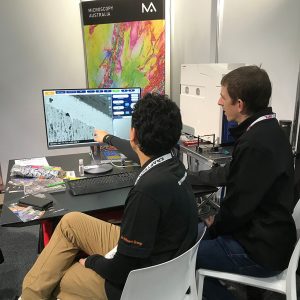An example of this was a packaging company that had a problem on its production line with metal sheeting from one supplier behaving inconsistently during processing. When the problem didn’t just go away, they consulted Microscopy Australia. Microscopic analysis demonstrated that the grain structure of the metal was not at specification, which accounted for its inconsistent behaviour. This gave the company the ammunition it needed to go back to the supplier who admitted their shortcomings, saving significant time and money.
This is also an example of the expertise that exists within Microscopy Australia and which can be applied to solving technical problems. This expertise goes hand-in-hand with its wide range of instruments to create a package of services to tackle anything from long-term R&D to quick turnaround fee-for-service jobs. Microscopy Australia is on a mission to support both emerging and established companies get access to the resources they need to address these problems.
Imaging and analysis at the micro and nano scale can also be used to provide evidence of structure and functionality needed to both promote a client’s products and, importantly, to attract investment. Not mentioning names for confidentiality reasons, a number of companies have reported that the evidence provided by Microscopy Australia’s analysis has been the decisive factor in attracting substantial new investment, gaining the required approvals for entering export markets or having critical patents granted.

Industry client at AMW2023
Microscopy Australia facilities are based in universities around Australia, surrounded by a dynamic multi-disciplinary research ecosystem. This means that as well as working directly with Microscopy Australia as described above, there are also opportunities for industry–university research partnerships that take advantage of the academic knowledge and longer-term access to Microscopy Australia’s instruments and expertise for product development. An example here is an industry–university collaboration that led to the commercialisation of the world’s first OEM-supplied shatterproof plastic mirror. SMR Automotive teamed up with the University of South Australia to develop a robust mirror for Ford. The technology has matured and is now appearing as decorative trim in cars across North America and Europe.
Microscopy Australia is also involved in enabling purely academic research projects, many of which are directly aimed at creating new materials and solutions for solving global problems. This pipeline of development provides a steady stream of new manufacturing business opportunities for industry. One example here is the green ceramic process developed at UNSW by Prof. Veena Sahajwalla and her team. This uses glass and textile waste to produce products for the built environment such as kitchen benchtops, floor and wall tiles, splashbacks and tabletops. Independent commercial operators, including, Kandui Technologies, have now established MICROfactoriesTM under licence to the Sustainable Materials Research & Technology (SMaRT) Centre to produce the green ceramic products commercially.
Another example is green concrete developed at the University of Sydney’s Waste Transformation Research Hub, which incorporates fly ash and waste materials including ground glass and gaseous carbon dioxide. Developed by Prof. Ali Abbas and his team, the technology has now been licensed to Circrete, a producer of environmental concrete.
The Microscopy Australia team aims to provide a bespoke imaging and analytical service to match industry needs and help solve their unique problems at competitive rates.
A slightly edited version of this story appeared in April/May 2024 issue of Industry Update.
Grain structure in a 3D-printed alloy
April 15, 2024